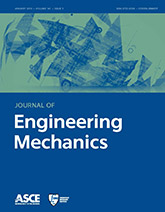Methodology for Regularization of Force-Based Elements to Model Reinforced Concrete Columns with Short Lap Splices

Zhang, Y., and Tien, I., “Methodology for Regularization of Force-Based Elements to Model Reinforced Concrete Columns with Short Lap Splices,” ASCE Journal of Engineering Mechanics, Vol. 146, No. 7, July 2020
Abstract — In reinforced concrete structures built before the 1970s, it was common for columns to be constructed with short lap splices and widely spaced transverse bars at the column base, leading to increased likelihoods of pull-out failures and structural collapse during seismic events. In the modeling and analysis of reinforced concrete columns with short lap splices, several challenges arise, particularly with softening behavior that leads to strain localization and scaling and convergence issues in analyses. This research presents a methodology to regularize force-based beam-column elements with softening lap-splice material response. In the methodology, a constant energy release criterion is imposed with the constant postpeak energy of the lap-splice region determined from relevant experimental data. With the proposed regularization, the numerical model shows objective results that are independent of the length of the element and number of integration points used. Whereas the accuracy in estimating, for example, the displacement at 20% strength drop using existing nonregularized models changes with the number of integration points, the accuracy using the proposed model remains constant across numbers of integration points used with a mean accuracy of 94% compared with experimental tests. Results from static pushover and cyclic analyses show an order of magnitude decrease in standard deviation of the response using the regularized model. Increased accuracy and increased convergence for the method across the number of integration points used is shown in static and dynamic analyses. The proposed regularization approach is able to alleviate strain localization issues and facilitates the scaling of analyses from small-scale to full-scale structures.